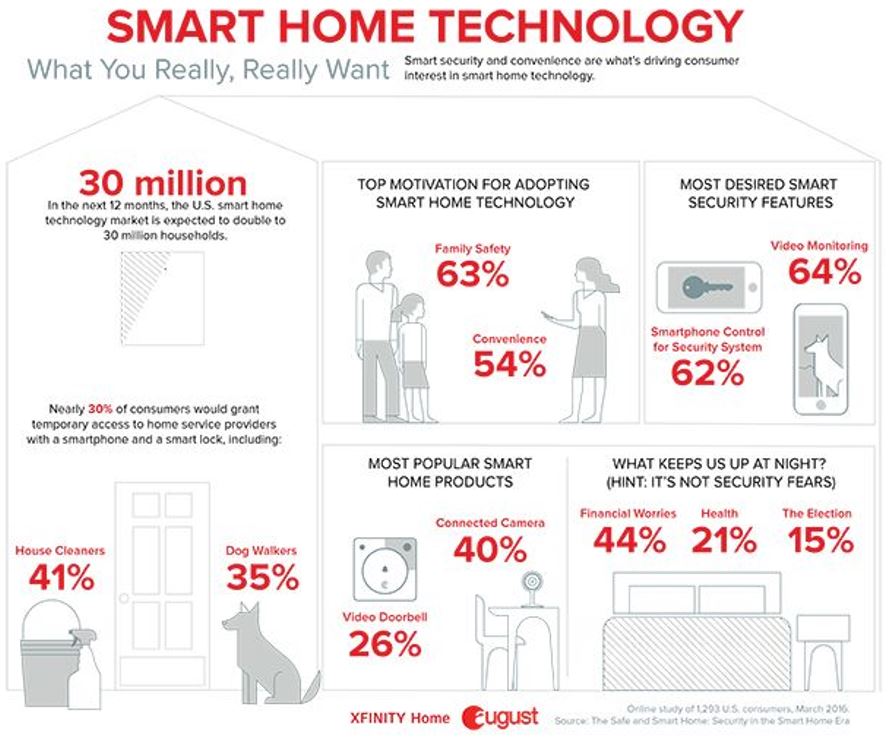With more people embracing mobile technology, smart homes, and the Internet of Things (IoT), home automation is gradually catching up with the smart technology that is now easily accessible and controllable from our pockets and purses.
A 2016 August Home and Xfinity Home study indicated that more people wanted to use a smart lock mechanism that comprised of connected cameras (40%), video doorbells (26%), and smart locks (13%). Most people (64%) wanted to use a clever lock mechanism to protect their families while 54% wanted the convenience connected locks afford them.

A NextMarket Insight study now forecasts the smart locks for home and businesses market to be worth about $3.6 billion by 2019 as more people embrace smart lock mechanisms that they can conveniently control from a smartphone screen.
What is A Smart Lock, Really?
Many people are already using a smart lock of sorts if the definition is one to run with.
Basically, a smart lock is an electrical and mechanical locking device that wirelessly opens after a user authenticates his or her identity to a connected database. There are different types of smart locks and levels of sophistication.
While the latest smart locks allow for 100% keyless entry, using only smartphone codes to validate the right people through, most people still prefer a combination of electronic and keyed lock mechanism—and cases such as the Airbnb smart door lock software update glitch make it tough for some people to totally trust keyless lock systems.
Keyed Smart Locks
The logic behind keyed smart locks is simple and based on the case of a blackout.
As far as electromagnetic door locks go, there are Fail Safe and Fail Secure models. Fail Safe locks unlock when power supply is cut while Fail Secure models remain locked when power fails or is intentionally switched off.
You will find Fail Secure locks in use cases such as safes while Fail Safe models are widely used in emergency doors and some not too sensitive locks in homes and office complexes.
Also, if you are concerned about smart home hacking incidences, the possibility of locking yourself out after forgetting your smart lock’s digital code, or want the extra security layer a physical key and deadbolt provides, you can find a model or smart locksmith London service to fix it for you.
The ideal smart door lock will have a keypad to enter your unique digital code before or after inserting a physical key into a deadbolt just underneath the keypad. The setup feels a lot like 2-step authentication.
The extra step can help deter a virtual burglary attempt meant to compromise the connected aspects of your smart door lock while simultaneously defending your deadbolt from successful physical interference.
Conclusion
With the digital migration happening at the doorstep and knob, you are now likely to find a smart door locksmith in London to help you take the calculated leap into home automation that guarantees both solid home security and remote control convenience.



 Low pay and few contracts make freelance journalism a bleak prospect in 2024
Low pay and few contracts make freelance journalism a bleak prospect in 2024  Kawhi Leonard and New Balance Launch the Highly Anticipated KAWHI IV Sneaker
Kawhi Leonard and New Balance Launch the Highly Anticipated KAWHI IV Sneaker  Meta AI to Supercharge WhatsApp, Facebook, Instagram via Powerful Integration
Meta AI to Supercharge WhatsApp, Facebook, Instagram via Powerful Integration  Google Fired Workers Protesting Over Cloud Contract Deal With Israel
Google Fired Workers Protesting Over Cloud Contract Deal With Israel  Nissan Cuts Profit Forecasts Amidst Sales Slump and Natural Disaster
Nissan Cuts Profit Forecasts Amidst Sales Slump and Natural Disaster  Polestar to Launch Polestar 4 Pure EV in South Korea
Polestar to Launch Polestar 4 Pure EV in South Korea  Tesla Dismisses 285 Buffalo, New York Workers in Restructuring Efforts
Tesla Dismisses 285 Buffalo, New York Workers in Restructuring Efforts  Coca-Cola Launches Global 'Recycle Me' Campaign to Champion Recycling
Coca-Cola Launches Global 'Recycle Me' Campaign to Champion Recycling  Adidas Unveils Innovative Team Kits for Paris 2024 Olympics and Paralympics
Adidas Unveils Innovative Team Kits for Paris 2024 Olympics and Paralympics  Samsung Implements Emergency 6-Day Work Week to Combat Slowing Growth
Samsung Implements Emergency 6-Day Work Week to Combat Slowing Growth  Samsung Targets Beijing’s EV Semiconductor Market at Auto China 2024
Samsung Targets Beijing’s EV Semiconductor Market at Auto China 2024  TSMC to Hike Prices for Chips Made Outside Taiwan, Impacting Global Device Costs
TSMC to Hike Prices for Chips Made Outside Taiwan, Impacting Global Device Costs  SPC Group’s Paris Baguette Inaugurates First Bakery Shop in the Philippines
SPC Group’s Paris Baguette Inaugurates First Bakery Shop in the Philippines  Sony Pictures, Apollo Global Reportedly In Talks to Jointly Bid for Paramount
Sony Pictures, Apollo Global Reportedly In Talks to Jointly Bid for Paramount  Starbucks Revamps Cups to Ease Plastic Waste; New Design to Roll Out in US, Canada
Starbucks Revamps Cups to Ease Plastic Waste; New Design to Roll Out in US, Canada  LG Electronics Eyes $1 Billion Through Bond Deal
LG Electronics Eyes $1 Billion Through Bond Deal 






























